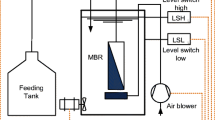Abstract
In this study, we modified a polytetrafluoroethylene (PTFE) hollow-fiber membrane element used for submerged membrane bioreactors (MBRs) to reduce the energy consumption during MBR processes. The high mechanical strength of the PTFE membrane made it possible to increase the effective length of the membrane fiber from 2 to 3 m. In addition, the packing density was increased by 20% by optimizing the membrane element configuration. These modifications improve the efficiency of membrane cleaning associated with aeration. The target of specific energy consumption was less than 0.4 kWh·m–3 in this study. The continuous operation of a pilot MBR treating real municipal wastewater revealed that the MBR utilizing the modified membrane element can be stably operated under a specific air demand per membrane surface area (SADm) of 0.13 m3·m–2·hr–1 when the dailyaveraged membrane fluxes for the constant flow rate and flow rate fluctuating modes of operation were set to 0.6 and 0.5 m3·m–2·d–1, respectively. The specific energy consumption under these operating conditions was estimated to be less than 0.37 kWh·m–3. These results strongly suggest that operating an MBR equipped with the modified membrane element with a specific energy consumption of less than 0.4 kWh·m–3 is highly possible.

Similar content being viewed by others
References
Judd S. The MBR Book: Principles and Applications of Membrane Bioreactors in Water and Wastewater Treatment. Oxford: Elsevier, 2006
Fenu A, Roels J,Wambecq T, De Gussem K, Thoeye C, De Gueldre G, Van De Steene B. Energy audit of a full scale MBR system. Desalination, 2010, 262(1–3): 121–128
Krzeminski P, van der Graaf J H J M, van Lier J B. Specific energy consumption of membrane bioreactor (MBR) for sewage treatment. Water Science and Technology, 2012, 65(2): 380–392
Barillon B, Martin Ruel S, Langlais C, Lazarova V. Energy efficiency in membrane bioreactors. Water Science and Technology, 2013, 67(12): 2685–2691
Buer T, Cumin J. MBR module design and operation. Desalination, 2010, 262(1–3): 1073–1077
Xiao K, Xu Y, Liang S, Lei T, Sun J, Wen X, Zhang H, Chen C, Huang X. Engineering application of membrane bioreactor for wastewater treatment in China: Current state and future prospect. Frontiers of Environmental Science & Engineering, 2014, 8(6): 805–819
Krzeminski P, Leverette L, Malamis S, Katsou E. Membrane bioreactors—A review on recent developments in energy reduction, fouling control, novel configurations, LCA and market prospects. Journal of Membrane Science, 2017, 527: 207–227
Tao G, Kekre K, Oo M H, Viswanath B, Aliman M D Y, Seah H. Energy reduction and optimisation in membrane bioreactors systems. Water Practice and Technology, 2010, 5(4): 88–93
Itokawa H, Tsuji K, Yamashita K, Hashimoto T. Design and operating experiences of full-scale municipal membrane bioreactors in Japan. Water Science and Technology, 2014, 69(5): 1088–1093
Hoque A, Kimura K, Miyoshi T, Yamato N, Watanabe Y. Characteristics of foulants in air-sparged side-stream tubular membranes used in a municipal wastewater membrane bioreactor. Separation and Purification Technology, 2012, 93: 83–91
Gil J A, Túa L, Rueda A, Montaño B, Rodríguez M, Prats D. Monitoring and analysis of the energy cost of an MBR. Desalination, 2010, 250(3): 997–1001
Verrecht B, Maere T, Nopens I, Brepols C, Judd S. The cost of a large-scale hollow fibre MBR. Water Research, 2010, 44(18): 5274–5283
Verrecht B, James C, Germain E, Ma W, Judd S. Experimental evaluation of intermittent aeration of a hollow fibre membrane bioreactor. Water Science and Technology, 2011, 63(6): 1217–1223
Ho J, Smith S, Roh H K. Alternative energy efficient membrane bioreactor using reciprocating submerged membrane. Water Science and Technology, 2014, 70(12): 1998–2003
Kurita T, Kimura K, Watanabe Y. Energy saving in the operation of submerged MBRs by the insertion of baffles and the introduction of granular materials. Separation and Purification Technology, 2015, 141(12): 207–213
Monclús H, Dalmau M, Gabarrón S, Ferrero G, Rodríguez-Roda I, Comas J. Full-scale validation of an air scour control system for energy savings in membrane bioreactors. Water Research, 2015, 79 (1): 1–9
Yan X, Wu Q, Sun J, Liang P, Zhang X, Xiao K, Huang X. Hydrodynamic optimization of membrane bioreactor by horizontal geometry modification using computational fluid dynamics. Bioresource Technology, 2016, 200: 328–334
Miyoshi T, Yamamura H, Morita T,Watanabe Y. Effect of intensive membrane aeration and membrane flux on membrane fouling in submerged membrane bioreactors: Reducing specific air demand per permeate (SADp). Separation and Purification Technology, 2015, 148(25): 1–9
Judd S. The status of industrial and municipal effluent treatment with membrane bioreactor technology. Chemical Engineering Journal, 2015, 305(1): 37–45
Japan Sewage Works Association. Standard Methods for the Examination of Wastewater. Japan Sewage Works Association, Tokyo, Japan (in Japanese)
Cornel P, Wagner M, Krause S. Investigation of oxygen transfer rates in full scale membrane bioreactors. Water Science and Technology, 2003, 47(11): 313–319
Krampe J, Krauth K. Oxygen transfer into activated sludge with high MLSS concentrations. Water Science and Technology, 2003, 47(11): 297–303
Germain E, Nelles F, Drews A, Pearce P, Kraume M, Reid E, Judd S J, Stephenson T. Biomass effects on oxygen transfer in membrane bioreactors. Water Research, 2007, 41(5): 1038–1044
Author information
Authors and Affiliations
Corresponding author
Rights and permissions
About this article
Cite this article
Miyoshi, T., Nguyen, T.P., Tsumuraya, T. et al. Energy reduction of a submerged membrane bioreactor using a polytetrafluoroethylene (PTFE) hollow-fiber membrane. Front. Environ. Sci. Eng. 12, 1 (2018). https://doi.org/10.1007/s11783-018-1018-y
Received:
Revised:
Accepted:
Published:
DOI: https://doi.org/10.1007/s11783-018-1018-y




